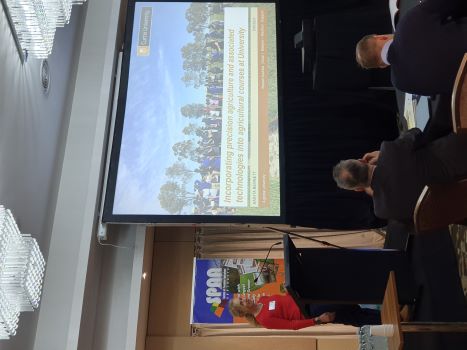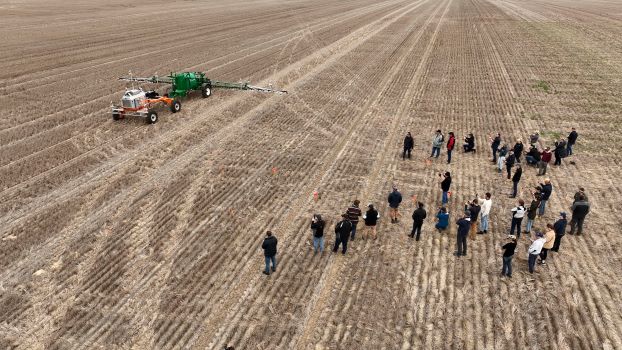Peer-to-peer learning events can be a powerful means to transfer knowledge, upskill and build connectivity within the grains industry.
The primary function of the Society of Precision Agriculture Australia (SPAA) is to promote the use of precision agriculture among Australian producers in order to increase production and sustainability. However, at its recent symposium the ability of its members to also reach into education to equip the next generation of practitioners was illustrated.
With support from GRDC, the 26th Australasian Precision Agriculture Symposium was hosted in Perth, Western Australia, in early September 2023 and drew more than 100 delegates, of whom about one-third were farmers. The latest information from agricultural sectors spanning grain, dairy and pork was shared on a wide range of topics from autonomous vehicles, soil water management, weed management, weather networks, satellites, data tech, the latest agricultural technology, education and more through presentations, interactive panel discussions and field demonstrations.
The symposium also provided an opportunity for ag-tech companies to display their technology and engage with practitioners. Additionally, it provided an opportunity for Curtin University’s Centre for Crop and Disease Management (CCDM) researchers to conduct a workshop bringing together machinery dealers, software providers, researchers and PA experts with growers to consider solutions to compatibility barriers between PA platforms.
Grain industry related
The following is a snapshot of information presented at the symposium of interest to grain growers.
Dr Michael Walsh from the University of Western Australia presented on novel weed control technologies. His update covered the use of blue light and mid-wave infra-red wavelength to kill growing weeds and weed seeds, and electrical methods of weed control including low-powered pulse systems. He also covered new weed recognition technologies, environmentally friendly use of gametocides, which prevent pollination in plants, and allelopathic chemicals produced by some crop species, which can also inhibit biological nitrification to boost more-efficient use of soil available nitrogen.
Bindi Isbister and Craig Topham, both representing Agrarian, reflected on 10 years of variable-rate technology using a case study farm that had been mapped and zoned for soil type and plant available water. Fertiliser has been applied using variable-rate technology and the zones had blanket rates of lime applied and were deep ripped.
This intensive management using PA approaches has seen yields double since the ripping and liming. However, even though the subsoil constraints have been removed, the soil type zones still have different yield potentials and require different fertiliser rates.
Outcomes from a soil water monitoring research project were presented by Associate Professor Ken Flower from UWA’s Australian Herbicide Resistance Initiative. The study used electromagnetic induction (EMI) to survey paddocks for various factors relating to water holding capacity, together with validation of the measurements using neutron moisture meter measurements at several depths. The research indicates the potential to provide three-dimensional soil water maps for growers.
Lessons from a participative action research project conducted by Dr Roger Lawes from CSIRO, together with the Stirlings to Coast Grower Group and Liebe Grower Group, were shared at the symposium. The project deployed a suite of PA tools to the groups and then, via surveys, gauged the uptake to determine how the technologies are perceived and used.
Growers highly valued weather forecasts, local weather information, weather apps and information relating to spraying conditions which were perceived as relatively easy to use and helped inform decisions around sowing and spraying. Yield maps were perceived to be useful but of moderate complexity and not used to make obvious decisions.
Satellite imagery was perceived as less useful than yield maps, harder to interpret and generally not used to make decisions. Crop models such as Agricultural Production Systems sIMulator (APSIM) and Yield Prophet were perceived as having use, but complex to understand and their direct real-world application unclear. The study concluded that technologies need to have a definite user case and be well supported by the industry.
Education
Associate Professor Sarita Bennett from Curtin University’s CCDM demonstrated the effectiveness of equipping agricultural graduates with knowledge of PA tools. The aim was to develop their confidence to implement and interpret the data these tools generate, and therefore assist growers in making informed decisions when they graduate.
 At the symposium Associate Professor Bennett demonstrated how students learnt from a case study provided by Bob Nixon. This consisted of several years of crop performance data from Bob’s north-eastern wheatbelt farm. Photo: Dr Sue Knights
At the symposium Associate Professor Bennett demonstrated how students learnt from a case study provided by Bob Nixon. This consisted of several years of crop performance data from Bob’s north-eastern wheatbelt farm. Photo: Dr Sue Knights
Curtin University has embedded the learning of PA tools alongside core units from first year onwards and in third year there is close engagement with industry so students can further practise their skills using real-world case studies in cropping and pasture systems.
These industry-relevant case studies are proving to be an engaging means to educate future farmers and agronomists who graduate from Curtin University’s agriculture degrees.
One such graduate from the Curtin University degree program is Brad Egan, who returned to the family farm at Scaddan, north of Esperance, bringing home a keenness to improve the management of the farm using PA technology. Brad shared his experience of adopting PA tools in his family business and then participated in a grower panel at the symposium.
The grower panel session consisted of five members from WA and South Australian cropping enterprises who were each posed two questions as a means of sharing their experiences and advice on adopting PA technology (Table 1).

Bot adoption experience shared
Brad Jones does not fear failure. Even when a hiccup occurs during a public display of his newly purchased bot, in front of a visiting group of delegates from the 2023 Australasian Precision Agriculture Symposium, he takes it in his stride.
“You have to check that you select the correct algorithm and adhere to processes,” Brad said. “The bot is not to blame, I did not adhere to process – it’s a rookie human error!”
It was intended that the bot demonstrate a spray application and Brad simply summoned it back to start again, found the correct button on the mobile phone app and the job was done.
“Processes are necessary when it comes to automation. We must remember that humans operate on perception informed by a multitude of senses; these robots are equipped with selected sensors and we must be strict with process.”

Brad Jones putting his robot ‘Vinnie’ through her paces during the 2023 Australasian Precision Agriculture Symposium field day. Photo: Anvil Media
Brad’s bot is from SwarmFarm, an innovative company supported by GRDC through its GrainInnovate venture capital fund. There are only four such bots in WA.
Every SwarmFarm bot is humanised by being given a unique name and Brad’s bot is affectionately known as ‘Vinnie’. He bought her in February 2023 and experimenting with the potential efficiencies she can bring to his farming operations.
“Humanising these bots by naming them may be somewhat ironic but you do need to get to know them,” Brad says.
Brad is using the bot platform to run a Greenacres spray unit fitted with Bilberry precision spray technology and operated by a Raven spray controller.
“It presents a few networks that need to talk to each other, and it takes a little time to establish connections when you first start the bot.”
Brad is using Vinnie to manage resistant weeds as she provides accurate spot spraying and can work around the clock.
Once we are confident that we are running her correctly she will free-up staff for other tasks on the farm to add value, but we will need to maintain oversight.
Putting Vinnie through her paces in front of visiting PA experts was an opportunity for Brad to source ideas and raise the profile of the technology in WA.
“This is the way of the future and we need to ensure we generate the support in the state to run these units.”
Scale and efficiencies
Brad and his wife Kate farm ‘Bungulla’ with five staff. It is an expansive property at Tammin, 180 kilometres north-east of Perth, where they crop a mix of 50 per cent wheat, 30 per cent canola, 15 per cent barley and 5 per cent oaten hay.
The scale of the property means Brad has introduced a workflow of key activities, which he reviews regularly. This workflow has feedback loops and adjustments, plus key points where data is collected.
Precision agriculture tools are used to collect much of the data and he has integrated tools as he has built the management framework and procedures over the years.
Soil is fundamental to our production system, so the paddocks were the first focus of attention and were mapped using electromagnetic mapping and soil sampled, then zoned to aid management efficiencies.
From this information prescription maps are developed each season.
Brad uses satellite NDVI maps, together with in-crop sap nitrate testing to assess nitrogen status. Nitrogen rich strips are used as a reference tool to monitor and assess in-crop nitrogen applications.
“We have also installed a network of 19 automated rainfall gauges and soil moisture monitors to generate spatial rainfall and moisture maps, with assistance from Origo Pty Ltd.”
“Using these we can better identify where to go within paddocks to identify production issues during the season, which reduces the laborious aspect of driving around paddocks.”
Temperature data is also logged each season that help to identify areas that may have been frosted during the season and require different management.
The data collected from the various tools on the farm are integrated using a selection of software platforms. It informs management decisions, ensures timely operations and identifies faults in the workflow.
Brad says the opportunity to be involved in peer-to-peer learning events raises his awareness of new technology coming on the market, builds connections and confidence.
Attitude to learning
“If you see someone else using new technology, it encourages you to try it as well, but it needs to be solving an issue for you.
“It may mean taking risks which involve assessments and you have to ask questions such as would it have a negative impact on the business. But taking that risk is fundamental to discovering what works and what doesn’t and brings improvements for your business.
It is a matter of balancing risk and dealing with the times you may fail. If you are gaining say 80 per cent of the time and losing 20 per cent, you are in front and making progress.
“This attitude can help build a growth mindset, resilience, deepen understanding and foster creativity.”
Brad shared four of his PA tips for new adopters in a SPAA case study publication four years ago and says these are just as relevant now:
- Figure out what you want to achieve with PA tools. For example, do you want to grow more or save costs? Then determine which tools are most appropriate.
- Talk to people about the technology. It is rapidly changing and continuous learning is required.
- Trust your data and commit to decisions informed by your data.
- You will make mistakes but this is an important part of learning.
More information: Society of Precision Agriculture Australia , [email protected]

























































